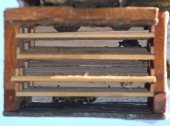posted 1 year ago
This study makes me think about how much we don't know. We are probably best off planting a diverse variety of veggies, fruit, herb, and flowers, and leave the critters to do what they do. I don't want to tempt fate, but this is working for me. Bees, moths, butterflies, wasps, I don't know who's doing what, but I'm happy they are doing what they do.
“We can complain because rose bushes have thorns, or rejoice because thorn bushes have roses.” — Abraham Lincoln






